A rude awakening
On Nov. 10, at 3 a.m., Raffi Elliott was roused from sleep by a huge commotion on the street outside his apartment building in downtown Yerevan.
Looking out of the window, Elliott, a Canadian-Armenian journalist and entrepreneur who moved to Armenia in 2012, saw a large crowd of angry protesters surging through the usually quiet street of the Armenian capital that runs from the National Assembly to the prime minister’s residence.
Hundreds of enraged protesters were heading from the parliament building towards the official residence of Prime Minister Nikol Pashinyan, denouncing him as a traitor to the nation and calling for his immediate resignation.
On the other side of the downtown, Neil Hauer, a Canadian journalist, who had arrived in Armenia a month earlier to cover the Nagorno-Karabakh war, witnessed similar scenes at the central Republic Square, which houses the main government headquarters.

Armenians protest against the country’s agreement to end fighting with Azerbaijan over the disputed Nagorno-Karabakh region outside the government headquarters in Yerevan on Nov. 10, 2020. (Karen Minasyan/AFP via Getty Images)
It all had to do with a Facebook post Armenia’s social media-savvy Prime Minister had posted at 1:48 a.m.
In it Pashinyan, a populist leader who in 2018 led a huge wave of peaceful protests against Armenia’s previous government mired in corruption, announced that after 44 days of bloody fighting in Nagorno-Karabakh, he was forced to sign a Russian-brokered ceasefire with Azerbaijan.
Fighting along the entire line of contact in Nagorno-Karabakh between Armenian and Azerbaijani forces erupted on Sept. 27, 2020, as Azerbaijan, backed by Turkey, launched a full-scale offensive to regain control of the breakaway region.
The nine-point ceasefire statement was personally mediated by President Vladimir Putin in late-night negotiations with Pashinyan and Azerbaijani President Ilham Aliyev. It amounted to Armenia’s near-total capitulation in a desperate attempt to save what remained of the Armenian-populated region now under the protection of about 2,000 Russian peacekeepers.
The humiliating ceasefire declaration was a bitter reversal of the victory Armenian forces had achieved in 1994, following the first Karabakh war.
Within minutes of Pashinyan’s Facebook post, Yerevan’s downtown erupted in angry protests.
“Chaos erupted almost instantly, within 10, 15 minutes, I was hearing cars driving past my apartment honking,” Hauer said. “There were just all sorts of people going there, honking, yelling.”
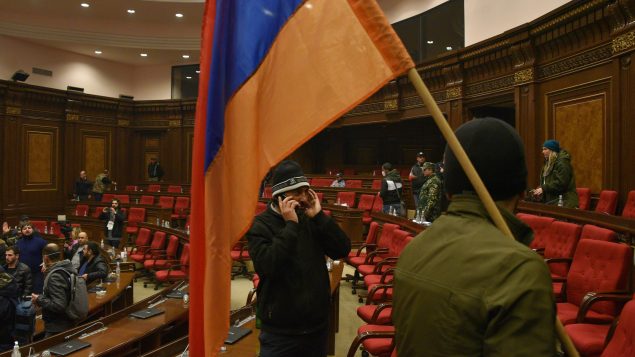
Armenians protest against the country’s agreement to end fighting with Azerbaijan over the disputed Nagorno-Karabakh region inside the parliament in Yerevan on Nov. 10, 2020. (Karen Minasyan/AFP via Getty Images)
The protesters ransacked the government headquarters, the parliament building and the prime minister’s residence. Parliament Speaker Ararat Mirzoyan was savagely beaten in front of his children by a mob who intercepted his car as he tried to get his family to safety.
Many of the people involved in the riots were later identified via security camera footage as having ties to the parties of the old regime overthrown in Pashinyan’s Velvet Revolution, but the shock of the ceasefire announcement reverberated through all sections of the society, Elliott said.
“I think a lot of people, though, were quite shocked at the news both in terms of how sudden it was given that most people had gone to bed knowing that the fighting was ongoing and that the situation, while not stellar, was under the control of the Armenian armed forces,” Elliott said.
“For many people waking up to the news, it was quite a shock, especially since there weren’t a lot of details associated with the announcement.”
Fog of war
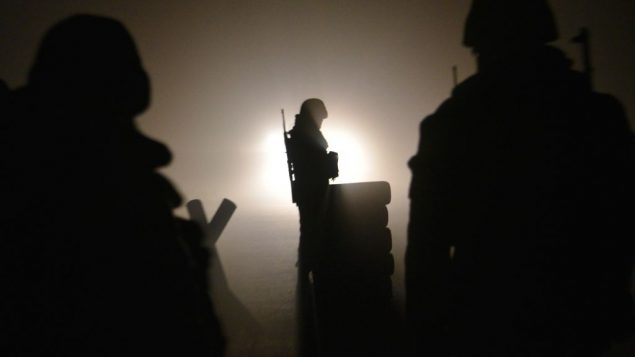
Armenian soldiers patrol at the check point outside Agdam to let last vehicles leave the region late on Nov. 19, 2020 as the territory is due to be returned to Azerbaijan on Nov. 20, 2020 as stipulated in a Moscow-brokered peace deal signed by Armenia and Azerbaijan on Nov. 9. (Karen Minasyan/AFP via Getty Images)
It wasn’t until the next day that Pashinyan, who had gone into hiding, and Arayik Harutyunyan, the leader of the self-proclaimed Republic of Artsakh, as Nagorno-Karabakh is known in Armenian, provided some explanation as to what had happened.
In separate but mutually reinforcing addresses, Pashinyan and Harutyunyan explained that in six weeks of relentless fighting, the outgunned and outnumbered Armenian forces in Nagorno-Karabakh had suffered a number of devastating setbacks, including the loss of the strategically and symbolically important town of Shushi, or Shusha as it’s known in Azerbaijani.
Facing the prospect of losing the regional capital of Stepanakert and the total encirclement of nearly 35,000 thousand Armenian troops, Armenia had no choice but to sue for peace in order to preserve at least those parts of Nagorno-Karabakh proper that were still under Armenian control, Pashinyan said.

(Map created by Emreculha/CC BY-SA 4.0)
Hauer said the dire situation on the frontlines revealed by Pashinyan and Harutyunyan came as a total shock to the majority of Armenians.
Up until the very end, most Armenians he spoke with told him they were confident that, just like during the war in the early 1990s, Armenian forces would eventually turn the tide, Hauer said.
The absolute majority of the population bought into the government messaging that despite losses and retreats, the Armenian military was still in control of the situation and that the Armenian forces were on the verge of a decisive victory in Shushi, he said.
“I mean a lot of it was, frankly, the propaganda on the Armenian side and people really ate it up,” Hauer said.
“And even to the degree that some of them were skeptical, I think people really did believe that, you know, the Azerbaijani losses were just massive and unsustainable and that basically the Armenians had ground them down to nothing.
“I think that’s an extra reason why people were so stunned, really, and shocked when the ceasefire deal was announced.”
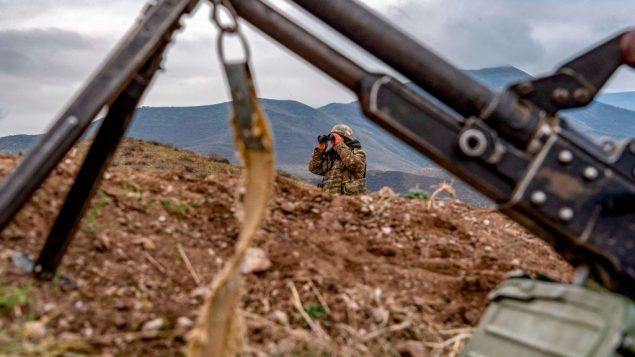
An Armenian soldier looks through binoculars during a patrol at the check point nearby a demarcation line outside Askeran on Nov. 21, 2020, as Azerbaijani troops moved the day before into the Aghdam district bordering Nagorno-Karabakh, following an Armenia and Azerbaijan agreement to a Russian-brokered ceasefire on Nov. 9 ending six weeks of fighting in the self-proclaimed republic. (Andrey Borodulin/AFP via Getty Images)
The price for stopping the fighting was the total withdrawal of Armenian forces from the remaining areas of Azerbaijan that Armenians had captured in 1993 and 1994. These areas were considered by many Armenians to be historic Armenian territories and were partly resettled by Armenian refugees from Azerbaijan.
The Azerbaijani military had already recaptured some of its territory along the border with Iran that was controlled by Armenians since 1994. In addition, Azerbaijan got to keep areas of Nagorno-Karabakh proper that its military had managed to seize prior to the ceasefire, including almost the entire district of Hadrut and the biggest prize of all, the mountaintop town of Shushi or Shusha.
And there wasn’t a single word in the page-long document about the status of Nagorno-Karabakh.
Nagorno-Karabakh lies within Azerbaijan but has been under the control of ethnic Armenians, who constitute the majority of the region’s population. In early 1988, Nagorno-Karabakh Armenians petitioned the Soviet authorities to transfer jurisdiction of the autonomous region from Baku to Yerevan.
The dispute over Nagorno-Karabakh’s status aroused nationalist passions both in Armenia and in Azerbaijan and quickly turned violent, leading to a series of anti-Armenian pogroms in Azerbaijan between 1988 and 1990, and violent reprisals against the Azebaijani minority in Armenia.
In December of 1991, days before the Soviet Union fell apart, the Nagorno-Karabakh Armenians, who comprised about 75 per cent of the region’s population, voted to secede from Azerbaijan. The Azerbaijani minority population of Nagorno-Karabakh boycotted the referendum and the government in Baku has never recognized the legitimacy of the self-declared republic.
In the ensuing war to reclaim the breakaway region by force, Azerbaijan was defeated and lost control of not only most of Nagorno-Karabakh itself but also seven surrounding regions of Azerbaijan proper.
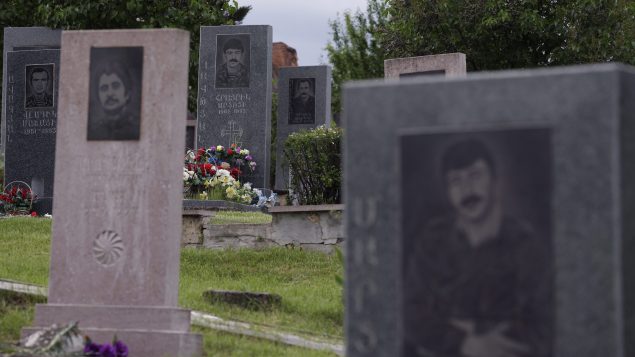
In this Thursday, May 10, 2018, a view of the soldiers cemetery with the victims of 1988-1994 war, in Stepanakert. Since a six-year separatist war ended in 1994, the mountainous region of Nagorno-Karabakh has been controlled by local ethnic Armenian forces backed by Armenia, yet the territory continues to be claimed by neighboring Azerbaijan which has fought all attempts by the self-proclaimed Republic of Artsakh for international recognition. (Thanassis Stavrakis/AP Photo)
The war in the early 1990s took the lives of up to 30,000 people and created nearly 1 million refugees.
The entire Armenian population of Azerbaijan outside of Nagorno-Karabakh fled to Armenia and other parts of the Soviet Union following the pogroms in Sumgait and Ganja in 1988, in Baku in 1990, and as a result of the 1991 Soviet “pacification” operations in a string of Armenian settlements in and around Nagorno-Karabakh.
Meanwhile, more than 700,000 Azerbaijanis were forced to flee Armenia, as well as their towns and villages in Nagorno-Karabakh and adjacent districts of Azerbaijan captured by the Armenian forces during the war.
“That was the bloodiest war in the South Caucasus and, for a long time, it was actually the bloodiest war in the whole post-Soviet space,” said Olesya Vartanyan, a senior analyst for the South Caucasus region with the International Crisis Group.
The war and its trauma have left a deep imprint in both Armenia and Azerbaijan, Vartanyan said.
“I had to grow up hearing all the stories about the war and all this impact because I am part of the first post-war generation,” Vartanyan said.
“I remember being a kid and hearing my grandmother almost whispering, talking to my niece about the developments in Nagorno-Karabakh. We all had to kind of internalize it a bit.”
Arzu Geybullayeva, an Azerbaijani journalist and author, said that she had a similar experience growing up on the other side of the conflict in Baku.
“I was born a couple of years before the war began and the relations [between Azerbaijanis and Armenians] really started souring and I grew up at a time when the war did take place and Nagorno-Karabakh became part of all of our lives – its status, the losses that we endured during the war,” Geybullayeva said.
“It’s a burden on everyone’s shoulders, especially with regard to being the side that lost the war in 1994.”
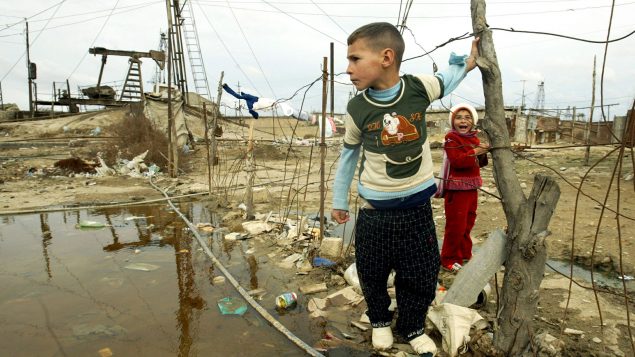
A boy and a girl stand by a littered pond in a refugee camp on an Azeri oil field near the village of Zabrat outside Baku Nov. 8, 2005. The Azeri refugees fled their homes in the mountainous Nagorno-Karabakh region during the war in the early 1990s and settled on the polluted land of a state-owned oil field near Baku. (Reuters)
Both Armenia and Azerbaijan reemerged as independent states during the conflict, Vartanyan said.
“All their state institutions and even the identities, I would say, were built around this conflict,” she said.
Separated by closed borders and peering at each other through the slits of their gun emplacements along hundreds of kilometres of trenches and military outposts that dotted the heavily militarized borders of the two countries and the line of contact in Nagorno-Karabakh, new generations of Armenians and Azerbaijanis grew up thinking of each other as enemies.
International efforts to find a peaceful solution to the conflict, led by Russia, the U.S. and France, the co-chairs of the Organization for Security and Cooperation in Europe (OSCE) Minsk Group, failed to bridge the gap between the two sides.
Azerbaijan insisted that it would never recognize the independence of Nagorno-Karabakh and could offer only an unspecified degree of autonomy, while demanding that its territorial integrity be restored and the seven districts around the Armenian-populated enclave be returned to it.
The Armenian side insisted that it would only return the seven districts if Azerbaijan agreed to a clearly spelled out process of determining Nagorno-Karabakh’s status through a legally binding referendum and internationally guaranteed security measures.
In 2015, with Western diplomatic interest in settling the conflict waning, Russia’s Foreign Affairs Minister Sergey Lavrov presented another peace plan, known as the Lavrov Plan, said Vartanyan.
The plan, which was kept secret until recently, envisaged the Armenian side returning five of the Azerbaijani districts immediately, then the two remaining ones later. The thorny issue of the status of Nagorno- Karabakh was to be postponed indefinitely, and security on the ground would be provided by Russian peacekeepers, Vartanyan said.
“Baku accepted it and even more, Baku was happy with the plan,” Vartanyan said. “The only thing that they were concerned about was the Russian peacekeepers. But the plan proposed so many good things to them along the lines that they wanted that even that was something that they were ready to close their eyes to.”
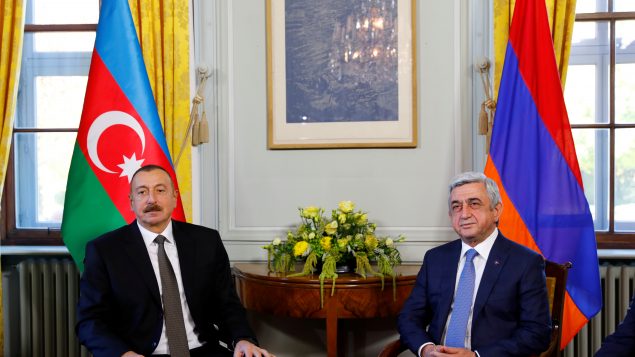
Azerbaijan President Ilham Aliyev (L) poses next to Armenian President Serzh Sargsyan at the opening of talks in Geneva, Switzerland Oct. 16, 2017. (Denis Balibouse/REUTERS)
But the Armenian president at the time, Serzh Sargsyan, balked at the proposal and demanded more clarity on the status of Nagorno-Karabakh.
That infuriated the Azerbaijanis, who could not believe that Russia with all its influence over Armenia could not force Sargsyan to accept the deal, Vartanyan said.
“That provoked enormous frustration in Baku, enormous,” Vartanyan said. “They started thinking that there is no potential for peace and the only option is the war.”
In April of 2016, Azerbaijan launched a surprise attack along the entire length of the line of contact in Nagorno-Karabakh and managed to capture a few Armenian positions in four days of fierce fighting until Russia brokered another ceasefire.
The limited success of the so-called April War gave Azerbaijan the confidence that its military, beefed up over the last two decades by multi-billion arms purchases, including with the latest Israeli drone and missile technology, could take on the heavily fortified Armenian positions.
In Armenia, the setbacks of the April War resulted in a political crisis, eventually leading to Pashinyan’s Velvet Revolution in 2018, which swept aside the corrupt political elites that had governed the country since 1998.
Pashinyan, who enjoyed enormous popularity at the time, had a small chance for a reset of the peace process, Vartanyan said.
“I’m sure he had very little space based on my interviews from that time, but still, you know, war is a very expensive thing and it’s a risky thing,” Vartanyan said. “And I believe there was a possibility to find a way to agree on certain things, at least not to get such a brutal and huge war as what we have just recently witnessed.”
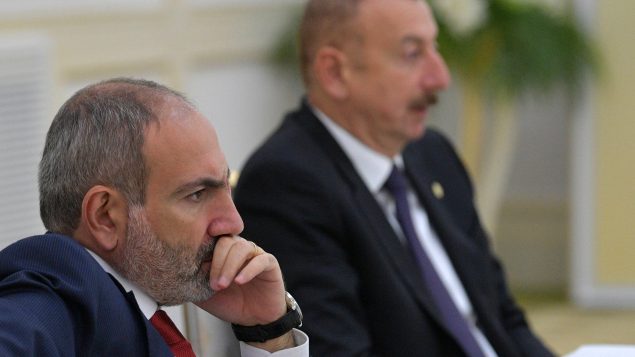
Armenia’s Prime Minister Nikol Pashinyan and Azerbaijan’s President Ilham Aliyev attend a meeting of heads of the Commonwealth of Independent States (CIS) in Ashgabat, Turkmenistan Oct.11, 2019. (Alexei Druzhinin/Sputnik/Kremlin via REUTERS)
After initial overtures to Aliyev, Pashinyan eventually hardened his position on the Nagorno-Karabakh settlement, arguing that the Armenian side simply cannot give up the territories demanded by Azerbaijan without getting in exchange some kind of a legally binding mechanism to determine the region’s status.
In July of 2020, the two countries came to blows again along their northern border, this time far from Nagorno-Karabakh.
The Armenian side claimed victory following several days of clashes that were the most serious uptick of violence since the 2016 April War.
If Pashinyan hoped that the demonstration of force would dissuade Aliyev from seeking to settle the conflict by military means, it had the exact opposite effect.
The setbacks suffered by the Azerbaijani military in July prompted Aliyev to turn to Turkey for help.
The two countries have strong cultural and linguistic ties, and Turkey has provided Azerbaijan with military and political support since its independence in 1991.
But this time it seems, Ankara was ready to step into the fray directly.
Almost immediately, Azerbaijan and Turkey began large-scale military maneuvers involving thousands of Turkish and Azerbaijani troops, as well as Turkish F-16 fighter jets and other equipment.
Turkey also transferred or sold to Azerbaijan about two dozen Bayraktar TB2 attack drones. These drones equipped with state-of-the-art Canadian optics and target acquisition systems were to play a crucial role in the war, according to several experts.
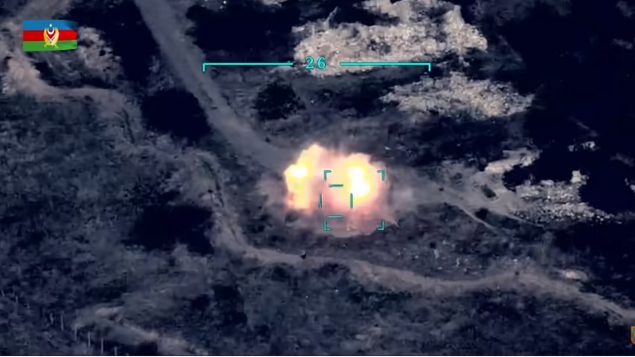
Still image pulled from drone video footage released by Azerbaijan’s ministry of defence purports to show an Azerbaijani combat drone targeting an Armenian air defence unit. Experts consulted by RCI, say the distinctive markings on the video are identical to the graphic interface of Canadian-produced WESCAM optical and laser targeting systems deployed on Turkish drones. (Azerbaijan MOD/YouTube)
Turkey also flew to Azerbaijan at least two thousand jihadist mercenaries from Syria and Libya, according to statements by Armenian, Russian, French and U.S. officials, which Ankara denies.
According to a report in the Russian newspaper Kommersant, citing confidential “military-diplomatic sources,” nearly 600 Turkish servicemen remained in Azerbaijan following the joint war games in July and August, and played a direct role in command and control of the fighting. Armenia has also alleged that the Turkish F-16 fighter jets participated in the attacks on Armenian positions and provided air cover for the Bayraktar drones.
Turkish and Azerbaijani officials have denied these reports, but were forced to admit that Turkish jets had remained in Azerbaijan after the New York Times published satellite photos of six F-16 jets sitting on the tarmac of the airport in Ganja, the country’s second largest city.
Turkey’s direct involvement in the war tilted the scales even more in favour of Azerbaijan, which already enjoyed significant numerical superiority and was far better armed thanks to its oil wealth, according to Alexander Gabuev, a Senior Fellow and Chair at Russia in the Asia‑Pacific Program of the Carnegie Moscow Center.
“I think that changed significantly the balance of power on the ground,” Gabuev said.
Azerbaijan and Turkey carefully chose the moment to launch the attack on Nagorno-Karabakh: the U.S. was absorbed in its own political drama before the election, the EU was busy with the pandemic and Russia was struggling with COVID-19 and the fallout of street protests in Belarus, Gabuev said.
“So not that much attention has been paid to what’s happening in Nagorno-Karabakh and not that much coordination between Paris, Washington, and Moscow was happening,” Gabuev said.
Turkey was also really very forceful in its military support and very vocal for the first time in its public support for Azerbaijan, he said.
While Moscow had no illusions that under the leadership of President Recep Tayyib Erdogan Turkey is becoming a very strong and a very ambitious regional power, stretching its influence from North Africa to the Balkans, to Central Asia and to South Caucasus, the degree of Turkey’s involvement caught the Kremlin off guard, Gabuev said.
From Russia with peace
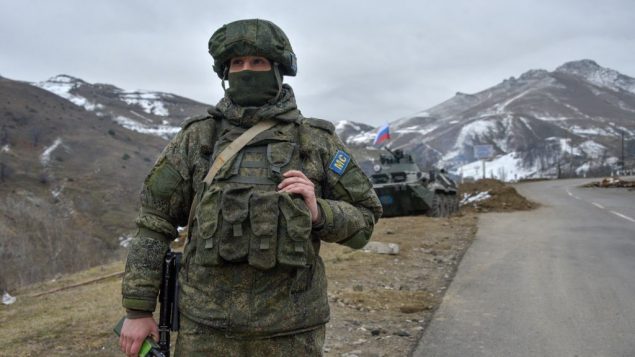
Russian soldiers of the peacekeeping force man a checkpoint on a road outside the town of Stepanakert on Nov. 26, 2020, after six weeks of fighting between Armenia and Azerbaijan over the disputed Nagorno-Karabakh region. (Karen Minasyan/AFP via Getty Images)
It presented Moscow with some uncomfortable choices and posed the risk that Russia could find itself drawn into a war with Turkey, something the Kremlin wanted to avoid at all costs.
Russia had always played a mediating role in the Nagorno-Karabakh conflict and performed a careful balancing act in the South Caucasus, which it saw as its sphere of influence and essential to preserving stability in the Russian North Caucasus, Gabuev said.
On the one hand, Armenia is an ally of Russia, and Moscow had a treaty obligation to protect it in case of a direct attack, he said. However, those treaty obligations did not apply to the territory of Nagorno-Karabakh, which Moscow recognizes as part of Azerbaijan, Gabuev said.
Russia also has excellent relations with Azerbaijan. Even though Baku has been able to move further away from Moscow’s orbit due to its energy wealth, it has done so in a way that does not threaten Russian interests in the region, he added.
Thus, for Russia, maintaining the status quo and peace was of paramount importance, Gabuev said.
“Yes, the [Nagorno-Karabakh] conflict was a guarantee that Russia will be in the region and it will be an indispensable partner for both Azerbaijan and Armenia,” Gabuev said.
“But even if the conflict were to be resolved, although the urgency of reaching out to Moscow would arguably be less, Russia still would be a towering presence in the region, a giant neighbor, a huge market, home for millions of Azeris and Armenians.”
Russia used its recent experience of dealing with Turkey in Syria and Libya, where their interests have clashed but Moscow and Ankara were able to find pragmatic solutions to their disagreements to avoid direct confrontation, Gabuev said.
Putin also used personal diplomacy, talking to Pashinyan and Aliyev – sometimes several times a day – to hammer out an agreement that eventually stopped the fighting. It got Azerbaijan almost everything it wanted and gave Russia a near-monopoly on the peacekeeping role in Nagorno-Karabakh, while at the same time keeping Turkey’s involvement to a minimum.
“I think that Russia managed to turn the situation where it had no good options into a situation where it’s still the most powerful outside player, and the fact that the statement was brokered by Moscow, was signed by the two leaders and President Vladimir Putin with no presence of President Erdogan, that’s really important,” Gabuev said.
For Russia’s national interests in the South Caucasus it’s also very important that it has boots on the ground in Nagorno-Karabakh and, as part of the agreement, Russian forces will also administer and patrol a road through Armenia proper that will connect Azerbaijan to its western exclave of Nakhichevan, Gabuev said.
At the same time, Turkey will be present as well through a joint ceasefire monitoring centre established on Azerbaijani territory, but not inside Nagorno Karabakh, he added.
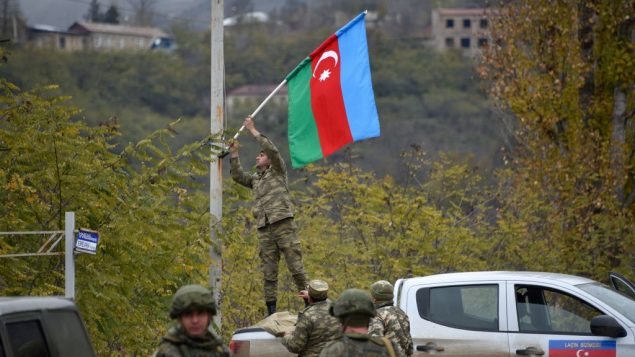
An Azerbaijani soldier fixes a national flag on a lamp post in the town of Lachin on Dec. 1, 2020. (Karen Minasyan/AFP via Getty Images)
But the Russian peacekeeping role is not without political risks, Gabuev said.
The agreement is for five years and is set to be automatically renewed if neither Armenia nor Azerbaijan ask the Russian peacekeepers to leave six months before its expiration.
It’s highly unlikely, however, that Armenia and Azerbaijan will find a diplomatic solution to the Nagorno-Karabakh conflict in that timeframe, Gabuev said.
“At some point, Russia might find itself in a situation where Baku will ask the Russians to leave and there will be a huge risk of renewed assault, resulting in the flight of the Armenian population and a huge humanitarian disaster,” Gabuev said.
“So then Russia will face a very grim choice: whether it wants to overstay the welcome of the Azerbaijanii government and say, ‘No, for humanitarian considerations, we will stay regardless of the agreement,’ or to withdraw with very dire consequences for the Armenian population and for its relationship with Armenia.”
Between war and peace
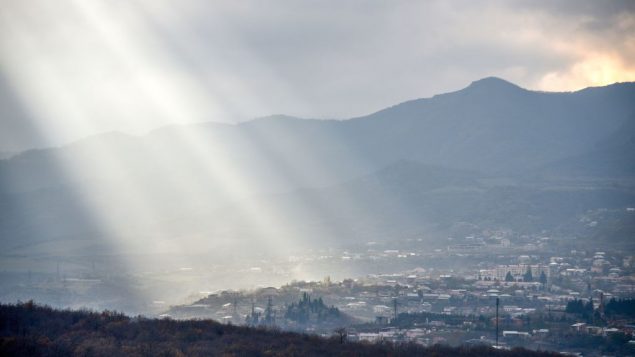
This pictures taken on Nov. 27, 2020 shows a view of Karabakh’s main city Stepanakert after six weeks of fighting between Armenia and Azerbaijan over the disputed Nagorno-Karabakh region. (Karen Minasyan/AFP via Getty Images)
Both Vartanyan and Gabuev agreed that it’s important for the OSCE Minsk Group and the UN to get involved in finding a political solution to the conflict.
“That’s where the Minsk format and the U.S. and the West might play a role in both managing the diplomatic resolution effort and then thinking about what happens after these five years,” Gabuev said.
Vartanyan said the Minsk group had already worked through a number of practical and conceptual issues and the OSCE has experience from other recent conflicts that would be applicable in Nagorno-Karabakh as well.
With Armenian refugees returning to Nagorno-Karabakh day by day and Azerbaijani refugees set to return to their towns and villages, there is a great need to find mechanisms to solve issues and disputes that will inevitably arise, she said.
“My concern is that there is very little experience of living together, especially with the post-war generation, not to mention that this war was extremely brutal, just to the extent that one cannot really imagine,” Vartanyan said. “People are extremely traumatized. And, yeah, it will be very difficult to rebuild any kind of trust.”
Vartanyan said in her conversations with diplomats who work on this issue she’s constantly raising the question of whether there is a space to set up certain systems that can help find ways to resolve these issues locally.
“I mean, of course, you can give calls to Moscow every time, for example, an incident happens,” Vartanayn said. “But I’m afraid that there are many other things, you know, on their plate and on the agenda in Moscow.”
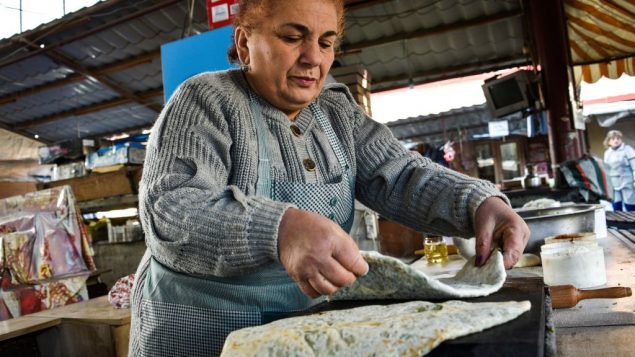
A vendor sells a traditional bread at a street market in Karabakh’s main city Stepanakert on Nov. 28, 2020, after six weeks of fighting between Armenia and Azerbaijan over the disputed Nagorno-Karabakh region. (Karen Minasyan/AFP via Getty Images)
Arzu Geybullayeva said there is a lot of work that needs to be done by the governments and societies in Azerbaijan and Armenia for any chance of peaceful coexistence.
“A lot of weight falls on the role of civil society organizations that used to engage in confidence building programs before the war and before relations really went into a downfall,” Geybullayeva said.
“The work that they’ve done in partnership with international organizations, whether through dialogue programs or joint initiatives, all of this needs to be brought back on the discussion table.”
However, many of these programs also need to be remodelled because the political and the geographic context of the conflict has changed, she added.
“We need to change the way we look at each other, the way Azerbaijanis see Armenians as perpetrators of violence and aggression, and the way Armenians see Azerbaijanis exactly the same way,” Geybullayeva said.
“And I’m not saying that this is how everybody thinks and both of the countries, but I am saying that the fact that this type of enmity exists regardless of the percentage of the people who think this way, it’s a dangerous element to have in the two countries that are actually trying to build bridges rather than destroy them.”
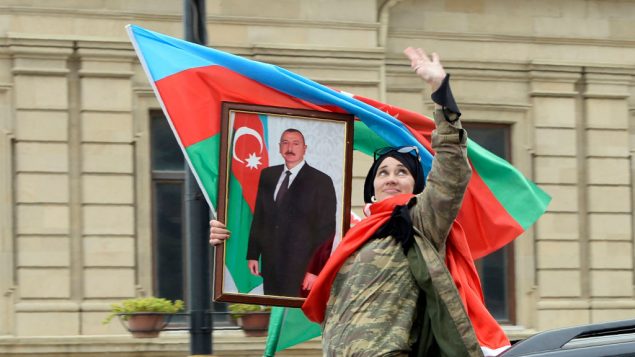
A woman holds the national flag and a portrait of Azerbaijan’s President Ilham Aliyev as people celebrate in the streets of the capital Baku on Nov. 10, 2020, after Armenia and Azerbaijan agreed a ceasefire following a string of Azeri victories in fighting over the disputed Nagorno-Karabakh region. (Tofik Babayev/AFP via Getty Images)
And it’s really important for the governments in Azerbaijan and Armenia to support these civil society initiatives and not look down upon them as often was the case in the past, she said.
Getting rid of the language of enmity and trying to look for things that Azerbaijanis and Armenians have in common rather than things that divide them is really important, Geybullayeva said.
“And that can only be achieved through just [changing] the way we look and we see, we interpret each other, the way we study each other and our textbooks, because I think textbooks also are quite an important element of this war and the atmosphere that exists in the two countries,” Geybullayeva said.
“And hopefully in some time, in some years, we will see some steps, some initiatives, some real stories coming out of this.”
For Raffi Elliott, the trilateral ceasefire deal presents both opportunities for reconciliation but also leaves a lot of unanswered questions.
“There’s that famous saying that’s attributed to the French 19th century economist Claude-Frédéric Bastiat, who said that when trade stops, when goods stop crossing borders, armies do,” Elliott said.
“Of course, in our particular case, the armies just stopped crossing the borders, so maybe there’s an opportunity for the goods to start crossing the borders. That’s certainly one potentially beneficial outcome.”
While trade often strengthens relationships between neighbouring countries, the kind of animosity that exists between Armenia and Azerbaijan doesn’t disappear overnight, he said.
“A lot of people bring up the example of France and Germany after WWII, but we also forget that Germany had the Nuremberg trials,” Elliott said. “Who is going to try the people who are responsible for these atrocities?”
The question of justice is primordial for Armenians for any hope of a lasting peace with either Azerbaijan or Turkey, Elliott said.
“The positive outcome, of course, of the war is that under Russian tutelage now, these borders are forced open, whether we like them or not,” he said.
“It’s unlikely that you will see Armenian tourists going across to visit Azerbaijan in the next five, 10, 20 or 100 years, but maybe will see truckers moving goods across, maybe people will realize that moving goods from Baku to Turkey through Armenia, for example, is more effective and cost efficient than going through Georgia.”
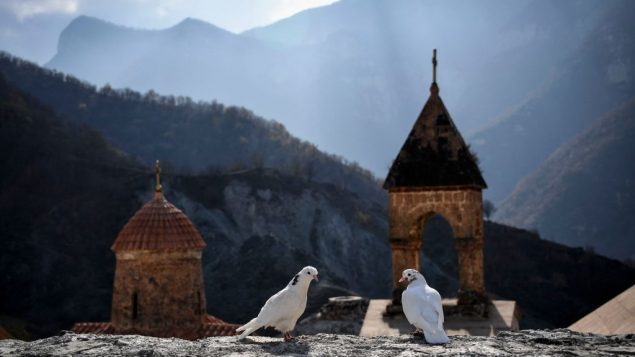






For reasons beyond our control, and for an undetermined period of time, our comment section is now closed. However, our social networks remain open to your contributions.